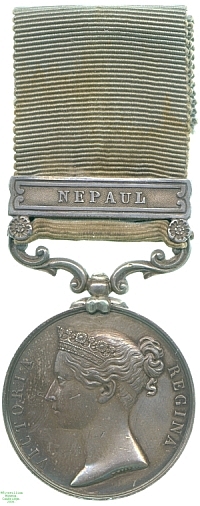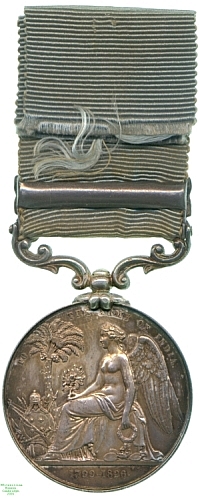
Obverse, a bust of Queen Victoria

Reverse, Victory seated facing left before a palm and war spoils, holding a laurel branch and wreath

Obverse, a bust of Queen Victoria |

Reverse, Victory seated facing left before a palm and war spoils, holding a laurel branch and wreath |
The numerous campaigns of the forces of the British East India Company were not officially recognised with a medal until 1851, in the same move as that which created the Military and Naval General Service Medals for service in the contemporary French Revolutionary and Napoleonic Wars. The resulting Army of India medal covered battles from 1799 to 1826, so many of those involved were no longer living. Queen Victoria, by whose order the medal was issued and whose bust it therefore carried, was likewise not on the throne for the actions for which it was awarded.
At the turn of the eighteenth and nineteenth centuries what is now Nepal was an area under pressure from two converging empires, the British in India and the Gurkhas of Kathmandu. The Gurkha Empire had been somewhat curtailed by war with China, but it and the British Empire had an undefined border in the Nepalese hills, in an area where a deliberately provocative Gurkha governor had been installed, and war inevitably followed in 1814. An unfortunate British campaign, in which one of the generals deserted, was nonetheless brought to a succesful conclusion in 1815, and when the Gurkhas failed to ratify the resulting treaty a more determined war was waged. The Treaty of Sugauli in 1816 resolved the conflict to the considerable benefit of the British East India Company.
This medal was awarded to Private P. McHugh of the 66th Foot. Lester Watson purchased this medal at some point before 1928.